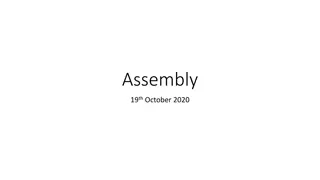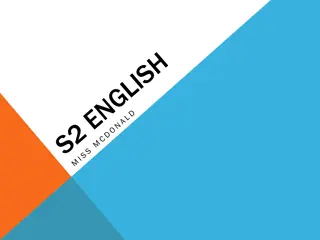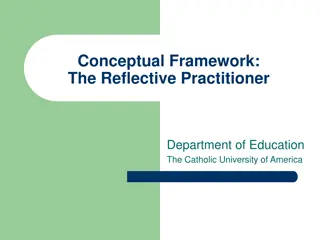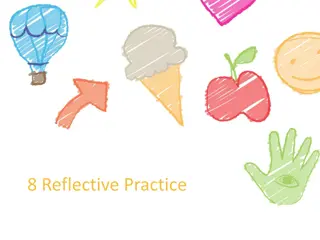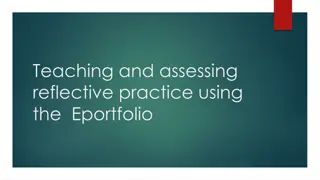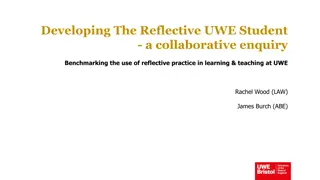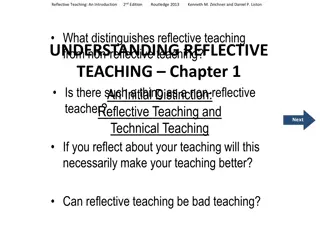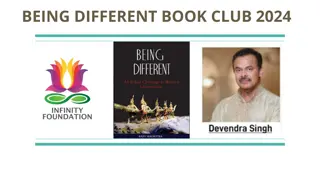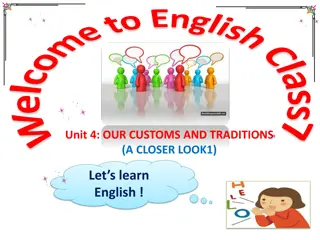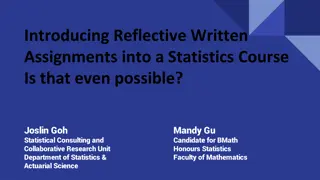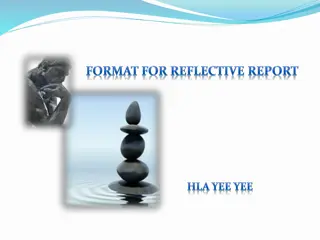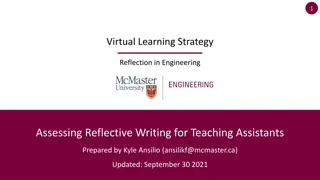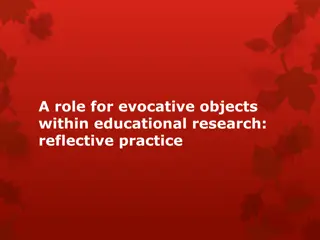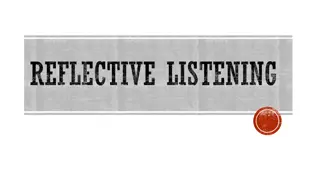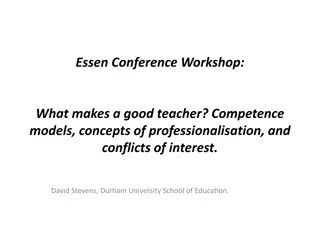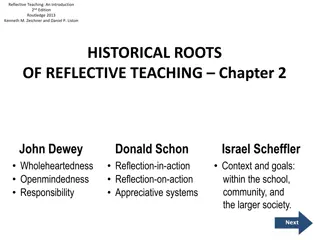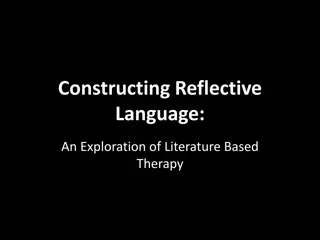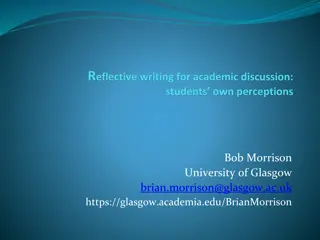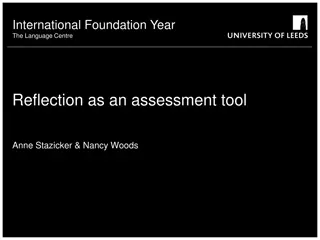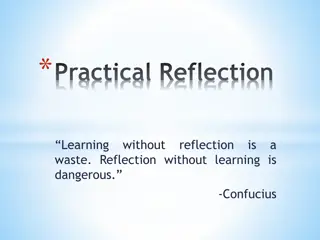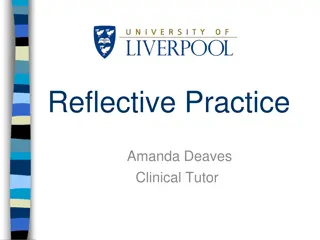Exploring Educational Traditions: Reflective Teaching Perspectives
This content delves into contrasting educational traditions like progressive and conservative approaches, emphasizing the importance of student-centered learning and meaningful curriculum connections. It discusses influential educators like John Dewey and E.D. Hirsch, highlighting their perspectives on active learning and knowledge acquisition. The narrative reflects on the ways in which traditions shape teaching methodologies and student outcomes.
- Education
- Reflective Teaching
- Student-Centered Learning
- Educational Traditions
- Curriculum Connections
Download Presentation

Please find below an Image/Link to download the presentation.
The content on the website is provided AS IS for your information and personal use only. It may not be sold, licensed, or shared on other websites without obtaining consent from the author. Download presentation by click this link. If you encounter any issues during the download, it is possible that the publisher has removed the file from their server.
E N D
Presentation Transcript
Reflective Teaching: An Introduction 2nd Edition Routledge 2013 Kenneth M. Zeichner and Daniel P. Liston Some tend to give greater pride of place in their First, we need to clarify the term tradition. educational designs to the content and skills conveyed (conservative) The term and the concept seem to denote a way of looking at the world that hangs heavy with relics from the past. Within this lens traditions constrain and direct, they REFLECTIVE TEACHING AND EDUCATIONAL TRADITIONS Chapter 5 do not engage or animate. Some to the constraining and oppressive social forces (social justice) Others to the needs and interests of the child (progressive) Social Justice Progressive Conservative Spiritual We don t see it that way. Andstill others to the soul enriching material that guides us through life (spiritual) Child Centered Context Centered Contemplation Centered Content Centered
John Dewey opposed what he understood as false dualisms (either/or formulations) and attempted to construct more productive solutions. He was quite critical of mindless memorization and forced repetition in the classroom. He worked so that the curriculum would not be seen as an imposition upon the child but rather as an embodiment of past human accomplishments, as well as an opportunity for students to explore thoroughly the world. schooling from the child s perspective. other progressive educators approach. The hallmark of the progressive tradition in education is its focus on the child. The progressive tradition has a long and storied past. At its core is a commitment to creating powerful and meaningful connections between the student and the curriculum. The Progressive Tradition Progressive educators, in some form or fashion, ask us to see learning and The creation of meaningful learning opportunities is central to Dewey s and
In our framework the conservative tradition underscores an approach to teaching that emphasizes All too often educational professionals hear the phrase conservative tradition and inwardly (and sometimes outwardly) frown. knowledge and skill acquisition, first and foremost. For many educationists the phrase The Conservative Tradition conjures up sour and snarly teachers as well as the absence of anything resembling an educational plan. conveyance and enhanced disciplinary understanding but tend not to see these views as conservative . Most educators are strongly committed to knowledge Conservatives seem to be the obstacles to humane, educational progress.
E. D. Hirsch is a tireless defender of a conservative approach to elementary education. While more nuanced and layered than what we can present here, his basic claims are as follows. known way of ensuring that all the students in a classroom will be sufficiently familiar with the context of classroom discourse to be able to learn new words and ideas from it. If verbal skill involves knowledge of things as much as knowledge of language, then there is a need to teach knowledge of things systematically, cumulatively, and coherently. The more effectively we do that, the higher will be our students achievement and the narrower will be the gaps between them. Additionally Hirsch explains that our use of language does not occur within an enclosed system. Language is used to name, describe, and understand physical, social, and psychological realities. Core Knowledge E.D. Hirsch He goes on to claim that: A carefully sequenced core curriculum is the only Students growing up with fewer economic and cultural resources persistently achieve less in school. They are not prepared at home in the ways that middle class and more economically advantaged children experience. In effect they receive less critical background knowledge than their more economically privileged peers. Without this critical background knowledge these students do not have an adequate basis for building on and enhancing their knowledge base.
In our democratic society, one that is divided by economic, racial, gender, and religious differences, schools are supposed to help all students learn. compete against their middle-class, suburban counterparts. For this and many other reasons democratic schools All too often poor, kids of color aren t given the tools that will enable them to The Social Justice Tradition But they don t. don t deliver on their democratic assurance. Our public schools tend to reproduce, not alter, the divisions in our society. Schooling for social justice attempts Schooling for social justice attempts to right these wrongs. to right these wrongs.
Proponents of social justice point not only to the number and variety of these harmful social forces but they also underscore the systemic or structural features of these dynamics of inequality. children of color. Within the last twenty years the social justice agenda has also focused on issues of privilege and anti-bias. Not all social justice programs are targeted for poor And so class, racial and gender inequalities are not simply the result of harmful prejudices or inappropriate attitudes but are part and parcel of a social system whose norms, rules and laws help the advantaged and further disempower the disadvantaged. students must come to terms with their relative privilege, the structural dynamics of class, gender, racial and sexual oppression, and their role within these dynamics. Here the claims tend to be that white privileged Today s more radically and social justice oriented proponents have embraced and developed further the now classic Freirean (Freire, 1973) calls for emancipatory educational practice. The Algebra Project , modeled after the 60s era Civil Rights movement, attempts to ensure that all students, especially poor urban students of color and impoverished white rural youth, gain the skills required to access more complex jobs in our information based society. Also within the last twenty years, many university based teacher education programs have embraced various forms of social justice teacher education .
There are moments in teaching when we experience beauty and wonder When a middle school student reads a passage that illuminates her personal heartfelt cost and you are momentarily at loss These are windows into beauty and wonder. When students share a deep, personal The Spiritual-Contemplative Tradition experience with meaning and connection for words: the sense of heartache can be great and indelible. When the student before us shows his depths through a doggedly, persistent approach to something ineffable and sacred that lies deeply within each human being, and transcends the human experience. Experiences of beauty and heartache point And other times when we face heartache and pain.
Rather than speaking of education as outcome mastery, Dwayne Huebner offers the notion of education as a journey . In the course of their education students and teachers pose significant life questions - these searches constitute individuals distinct educational journeys. Instead of seeing the curriculum as material to be mastered, Huebner construes it as meaningful encounters with various forms of the other . He reminds us that: Sam Intrator has described the epiphanies of teaching and learning those moments in our ordinary educational lives when we get a sudden flash of insight and understanding. What makes an educational experience sacred what gives it spiritual dimensions? intellectual conundrums. They address questions of significant life meaning and affect our head, heart, body and soul. second discipline is a disciplining of the mind, not in the sense of staying on top of all the educational research and literature, but in the sense of developing an imagination that has room for the spiritual. ... it is futile to hope that teachers can be aware of the These insights tend to be more than solutions to spiritual in education unless they maintain some form of spiritual discipline. This needs to be of two kinds. Given the inherent conflicts involved in teaching, and the inherent vulnerability of their vocation, teachers need to seek out communities of faith, love and hope. [ ] The


